
Apart from the popularity of sport, it has been found that sheep-farming
does not pay as it did in 1840-1870, so every year more and more ground is
afforested; high rents with no risk to the owner can be obtained by converting
the sheep ground into Deer forest. In North-west Ross and Inverness, where
the grass is of the finest quality, this is especially the case.
There is no direct evidence to show that Red Deer were ever inhabitants of
Orkney and Shetland. Horns have been found in the graves of the chiefs of
Orkney, and in 1904 the complete skull and horns of a Red Deer were found
buried in the peat near Kirkwall.
Red Deer were abundant in Ireland in the Pleistocene Age, and the earliest
chronicler of Irish history, an ecclesiastic named Augustine, who wrote about the
middle of the seventh century, mentions them among the mammals indigenous to the
country in the following passage:— ‘Quis enim verbi gratia lupos, cervos, et sylvaticos
porcos et vulpes, taxones et lepusculos et sesquivolos in Hiberniam deveneret ? *
Giraldus Cambrensis (a.d. 1183-86) does not include them among the animals not
found in Ireland. Fynes Moryson1 refers to the species in the following passage:
‘ Yet in many woods they have many Red Deer loosely scattered, which seem
more plentiful because the inhabitants used not to hunt them, but only the
governors and commanders had them sometimes killed with the piece.’ In Smith’s
‘ History of Waterford’ (1774) we read that there were a few wild Red Deer in
the Knockmeledown Mountains, but they were then rapidly becoming extinct.2
At the present day wild Red Deer are found in the forests of Kenmare and
Muckross in Kerry, where they are still preserved and numerous.
H abits.— Beyond question the Red Stag is the finest wild animal that our
islands contain. With his delicate nostrils accepting the breeze, and his head thrown
well back, he looks the embodiment of all that is noble and free. Away up in his
home among the clouds there is something majestic in his bearing. He is just
the right thing in the right place. We expect to see something of the kind in that
towering world of rocks and waterfalls, and we are not disappointed. He is the
very spirit of the northern wastes, and in his stronghold among the boulders of
the grass forests he looks around with the tranquillity of possession. The giant
moose, the great white-necked caribou, and the noble antlered wapiti are each and
all fascinating to those who have hunted them, but in dignity of movements none
can compare with the Red Stag as he moves up the hillside with his machine-like
trot, the very embodiment of grace and beauty,
1 A n History o f Ireland from the Year 1599 to 1603, &c.
4 For further information about the Red Deer in Ireland see Ussher, Zoologist, March 1882.